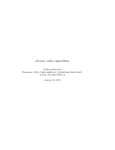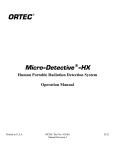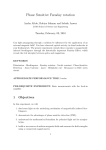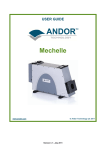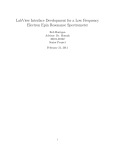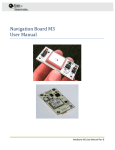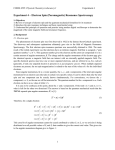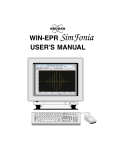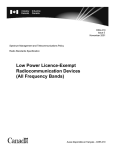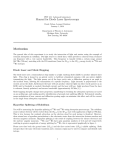Download EMX User`s Manual
Transcript
An EPR Primer 2 This chapter is an introduction to the basic theory and practice of EPR spectroscopy. It gives you sufficient background to understand the following chapters. In addition, we strongly encourage the new user to explore some of the texts and articles at the end of this chapter. You can then fully benefit from your particular EPR application or think of new ones. Basic EPR Theory 2.1 Introduction to Spectroscopy 2.1.1 During the early part of this century, when scientists began to apply the principles of quantum mechanics to describe atoms or molecules, they found that a molecule or atom has discrete (or separate) states, each with a corresponding energy. Spectroscopy is the measurement and interpretation of the energy differences between the atomic or molecular states. With knowledge of these energy differences, you gain insight into the identity, structure, and dynamics of the sample under study. We can measure these energy differences, ∆E, because of an important relationship between ∆E and the absorption of electromagnetic radiation. According to Planck's law, electromagnetic radiation will be absorbed if: ∆E = hν , [2-1] where h is Planck's constant and ν is the frequency of the radiation. EMX User’s Manual Basic EPR Theory ∆E Figure 2-1 hν Transition associated with the absorption of electromagnetic energy. The absorption of energy causes a transition from the lower energy state to the higher energy state. (See Figure 2-1.) In conventional spectroscopy, ν is varied or swept and the frequencies at which absorption occurs correspond to the energy differences of the states. (We shall see later that EPR differs slightly.) This record is called a spectrum. (See Figure 2-2.) Typically, the frequencies vary from the megahertz range for NMR (Nuclear Magnetic Resonance) (AM, FM, and TV transmissions use electromagnetic radiation at these frequencies), through visible light, to ultraviolet light. Radiation in the gigahertz range (the same as in your microwave oven) is used for EPR experiments. hν1 hν2 Absorption ν1 ν Figure 2-2 2-2 A spectrum. ν2 Basic EPR Theory The Zeeman Effect 2.1.2 The energy differences we study in EPR spectroscopy are predominately due to the interaction of unpaired electrons in the sample with a magnetic field produced by a magnet in the laboratory. This effect is called the Zeeman effect. Because the electron has a magnetic moment, it acts like a compass or a bar magnet when you place it in a magnetic field, B0. It will have a state of lowest energy when the moment of the electron, µ, is aligned with the magnetic field and a state of highest energy when µ is aligned against the magnetic field. (See Figure 2-3.) The two states are labelled by the projection of the electron spin, Ms, on the direction of the magnetic field. Because the electron is a spin 1/2 particle, the parallel state is designated as Ms = - 1/2 and the antiparallel state is Ms = + 1/2. B0 Figure 2-3 EMX User’s Manual B0 Minimum and maximum energy orientations of µ with respect to the magnetic field B0. 2-3 Basic EPR Theory From quantum mechanics, we obtain the most basic equations of EPR: 1 E = g µB B0 Ms = ± --- g µB B0 2 [2-2] ∆E = hν = g µBB0. [2-3] and g is the g-factor, which is a proportionality constant approximately equal to 2 for most samples, but varies depending on the electronic configuration of the radical or ion. µ B is the Bohr magneton, which is the natural unit of electronic magnetic moment. Two facts are apparent from equations Equation [2-2] and Equation [2-3] and its graph in Equation Figure 2-4. • The two spin states have the same energy in the absence of a magnetic field. • The energies of the spin states diverge linearly as the magnetic field increases. These two facts have important consequences for spectroscopy. • Without a magnetic field, there is no energy difference to measure. • The measured energy difference depends linearly on the magnetic field. 2-4 Basic EPR Theory Because we can change the energy differences between the two spin states by varying the magnetic field strength, we have an alternative means to obtain spectra. We could apply a constant magnetic field and scan the frequency of the electromagnetic radiation as in conventional spectroscopy. Alternatively, we could keep the electromagnetic radiation frequency constant and scan the magnetic field. (See Figure 2-4.) A peak in the absorption will occur when the magnetic field “tunes” the two spin states so that their energy difference matches the energy of the radiation. This field is called the “field for resonance”. Owing to the limitations of microwave electronics, the latter method offers superior performance. This technique is used in all Bruker EPR spectrometers. ∆E Absorption B0 Figure 2-4 EMX User’s Manual Variation of the spin state energies as a function of the applied magnetic field. 2-5 Basic EPR Theory The field for resonance is not a unique “fingerprint” for identification of a compound because spectra can be acquired at several different frequencies. The g-factor, hν g = -------------- , µ B B0 [2-4] being independent of the microwave frequency, is much better for that purpose. Notice that high values of g occur at low magnetic fields and vice versa. A list of fields for resonance for a g = 2 signal at microwave frequencies commonly available in EPR spectrometers is presented in Table 2-1. Microwave Band Bres (G) L 1.1 392 S 3.0 1070 X 9.75 3480 Q 34.0 12000 W 94.0 34000 Table 2-1 2-6 Frequency (GHz) Field for resonance, Bres, for a g = 2 signal at selected microwave frequencies. Basic EPR Theory Hyperfine Interactions 2.1.3 Measurement of g-factors can give us some useful information; however, it does not tell us much about the molecular structure of our sample. Fortunately, the unpaired electron, which gives us the EPR spectrum, is very sensitive to its local surroundings. The nuclei of the atoms in a molecule or complex often have a magnetic moment, which produces a local magnetic field at the electron. The interaction between the electron and the nuclei is called the hyperfine interaction. It gives us a wealth of information about our sample such as the identity and number of atoms which make up a molecule or complex as well as their distances from the unpaired electron. B0 BI Electron Nucleus B0 BI Electron Figure 2-5 EMX User’s Manual Nucleus Local magnetic field at the electron, BI, due to a nearby nucleus. 2-7 Basic EPR Theory Equation Figure 2-5 depicts the origin of the hyperfine interaction. The magnetic moment of the nucleus acts like a bar magnet (albeit a weaker magnet than the electron) and produces a magnetic field at the electron, BI. This magnetic field opposes or adds to the magnetic field from the laboratory magnet, depending on the alignment of the moment of the nucleus. When BI adds to the magnetic field, we need less magnetic field from our laboratory magnet and therefore the field for resonance is lowered by BI. The opposite is true when BI opposes the laboratory field. For a spin 1/2 nucleus such as a hydrogen nucleus, we observe that our single EPR absorption signal splits into two signals which are each B I away from the original signal. (See Figure 2-6.) BI Figure 2-6 BI Splitting in an EPR signal due to the local magnetic field of a nearby nucleus. If there is a second nucleus, each of the signals is further split into a pair, resulting in four signals. For N spin 1/2 nuclei, we will generally observe 2N EPR signals. As the number of nuclei gets larger, the number of signals increases exponentially. Sometimes there are so many signals that they overlap and we only observe one broad signal. 2-8 Basic EPR Theory Signal Intensity 2.1.4 So far, we have concerned ourselves with where the EPR signal is, but the size of the EPR signal is also important if we want to measure the concentration of the EPR active species in our sample. In the language of spectroscopy, the size of a signal is defined as the integrated intensity, i.e., the area beneath the absorption curve. (See Figure 2-7.) The integrated intensity of an EPR signal is proportional to the concentration. Figure 2-7 Integrated intensity of absorption signals. Both signals have the same intensity. Signal intensities do not depend solely on concentrations. They also depend on the microwave power. If you do not use too much microwave power, the signal intensity grows as the square root of the power. At higher power levels, the signal diminishes as well as broadens with increasing microwave power levels. This effect is called saturation. If you want to measure accurate linewidths, lineshapes, and closely spaced hyperfine splittings, you should avoid saturation by using low microwave power. A quick means of checking for the absence of saturation is to decrease the microwave power and verify that the signal intensity also decreases by the square root of the microwave power. EMX User’s Manual 2-9 Basic EPR Practice Basic EPR Practice 2.2 Introduction to Spectrometers 2.2.1 In the first half of this chapter, we discussed the theory of EPR spectroscopy. Now we need to consider the practical aspects of EPR spectroscopy. Theory and practice have always been strongly interdependent in the development and growth of EPR. A good example of this point is the first detection of an EPR signal by Zavoisky in 1945. The Zeeman effect had been known in optical spectroscopy for many years, but the first direct detection of EPR had to wait until the development of radar during World War II. Only then, did scientists have the necessary components to build sufficiently sensitive spectrometers (scientific instruments designed to acquire spectra). The same is true today with the development of advanced techniques in EPR such as Fourier Transform and high frequency EPR. The simplest possible spectrometer has three essential components: a source of electromagnetic radiation, a sample, and a detector. (See Figure 2-8.) To acquire a spectrum, we change the frequency of the electromagnetic radiation and measure the amount of radiation which passes through the sample with a detector to observe the spectroscopic absorptions. Despite the apparent complexities of any spectrometer you may encounter, it can always be simplified to the block diagram shown in Figure 2-8. Source Figure 2-8 2-10 Sample The simplest spectrometer. Detector Basic EPR Practice Figure 2-9 shows the general layout of a Bruker EPR spectrometer. The electromagnetic radiation source and the detector are in a box called the “microwave bridge”. The sample is in a microwave cavity, which is a metal box that helps to amplify weak signals from the sample. As mentioned in Section 2.1.2, there is a magnet to “tune” the electronic energy levels. In addition, we have a console, which contains signal processing and control electronics and a computer. The computer is used for analyzing data as well as coordinating all the units for acquiring a spectrum. In the following sections you will become acquainted with how these different parts of the spectrometer function and interact. Bridge Cavity and Sample Console Magnet Figure 2-9 The general outlay of an EPR spectrometer. EMX User’s Manual 2-11 Basic EPR Practice Signal Out G Reference Arm Detector Diode E F Source A C Attenuator B Circulator D Cavity Figure 2-10 2-12 Block diagram of a microwave bridge. Basic EPR Practice The Microwave Bridge 2.2.2 The microwave bridge houses the microwave source and the detector. There are more parts in a bridge than shown in Figure 2-10, but most of them are control, power supply, and security electronics and are not necessary for understanding the basic operation of the bridge. We shall now follow the path of the microwaves from the source to the detector. We start our tour of the microwave bridge at point A, the microwave source. The output power of the microwave source cannot be varied easily, however in our discussion of signal intensity, we stressed the importance of changing the power level. Therefore, the next component, at point B, after the microwave source is a variable attenuator, a device which blocks the flow of microwave radiation. With the attenuator, we can precisely and accurately control the microwave power which the sample sees. Bruker EPR spectrometers operate slightly differently than the simple spectrometer shown in the block diagram, Figure 2-8. The diagram depicts a transmission spectrometer (It measures the amount of radiation transmitted through the sample.) and most EPR spectrometers are reflection spectrometers. They measure the changes (due to spectroscopic transitions) in the amount of radiation reflected back from the microwave cavity containing the sample (point D in the figure). We therefore want our detector to see only the microwave radiation coming back from the cavity. The circulator at point C is a microwave device which allows us to do this. Microwaves coming in port 1 of the circulator only go to the cavity through port 2 and not directly to the detector through port 3. Reflected microwaves are directed only to the detector and not back to the microwave source. We use a Schottky barrier diode to detect the reflected microwaves (point E in the figure). It converts the microwave power to an electrical current. At low power levels, (less than 1 microwatt) the diode current is proportional to the microwave power and the detector is called a square law detector. (Remember that EMX User’s Manual 2-13 Basic EPR Practice electrical power is proportional to the square of the voltage or current.) At higher power levels, (greater than 1 milliwatt) the diode current is proportional to the square root of the microwave power and the detector is called a linear detector. The transition between the two regions is very gradual. For quantitative signal intensity measurements as well as optimal sensitivity, the diode should operate in the linear region. The best results are attained with a detector current of approximately 200 microamperes. To insure that the detector operates at that level, there is a reference arm (point F in the figure) which supplies the detector with some extra microwave power or “bias”. Some of the source power is tapped off into the reference arm, where a second attenuator controls the power level (and consequently the diode current) for optimal performance. There is also a phase shifter to insure that the reference arm microwaves are in phase with the reflected signal microwaves when the two signals combine at the detector diode. The detector diodes are very sensitive to damage from excessive microwave power and will slowly lose their sensitivity. To prevent this from happening, there is protection circuitry in the bridge which monitors the current from the diode. When the current exceeds 400 microamperes, the bridge automatically protects the diode by lowering the microwave power level. This reduces the risk of damage due to accidents or improper operating procedures. However, it is good lab practice to follow correct procedures and not rely on the protection circuitry. 2-14 Basic EPR Practice The EPR Cavity 2.2.3 In this section, we shall discuss the properties of microwave (EPR) cavities and how changes in these properties due to absorption result in an EPR signal. We use microwave cavities to amplify weak signals from the sample. A microwave cavity is simply a metal box with a rectangular or cylindrical shape which resonates with microwaves much as an organ pipe resonates with sound waves. Resonance means that the cavity stores the microwave energy; therefore, at the resonance frequency of the cavity, no microwaves will be reflected back, but will remain inside the cavity. (See Figure 2-11.) Reflected Microwave Power ν Figure 2-11 ∆ν νres Reflected microwave power from a resonant cavity. Cavities are characterized by their Q or quality factor, which indicates how efficiently the cavity stores microwave energy. As Q increases, the sensitivity of the spectrometer increases. The Q factor is defined as 2 π (energy stored) Q = ----------------------------------------------------------------- , energy dissipated per cycle [2-5] where the energy dissipated per cycle is the amount of energy lost during one microwave period. Energy can be lost to the side walls of the cavity because the microwaves generate electrical currents in the side walls of the cavity which in turn generates EMX User’s Manual 2-15 Basic EPR Practice heat. We can measure Q factors easily because there is another way of expressing Q: ν res Q = --------- , ∆ν [2-6] where νres is the resonant frequency of the cavity and ∆ν is the width at half height of the resonance. Sample Stack Sample Stack Microwave Magnetic Field Figure 2-12 Microwave Electric Field Magnetic and electric field patterns in a standard EPR cavity. A consequence of resonance is that there will be a standing wave inside the cavity. Standing electromagnetic waves have their electric and magnetic field components exactly out of phase, i.e. where the magnetic field is maximum, the electric field is minimum and vice versa. The spatial distribution of the amplitudes of the electric and magnetic fields in the most commonly used EPR cavity is shown in Figure 2-12. We can use the spatial separation of the electric and magnetic fields in a cavity to great advantage. Most samples have non-resonant absorption of the microwaves via the electric field (this is how a microwave oven works) and the Q will be degraded by an increase in the dissipated energy. It is the magnetic field that drives the absorption in 2-16 Basic EPR Practice EPR. Therefore, if we place our sample in the electric field minimum and the magnetic field maximum, we obtain the biggest signals and the highest sensitivity. The cavities are designed for optimal placement of the sample. We couple the microwaves into the cavity via a hole called an iris. The size of the iris controls the amount of microwaves which will be reflected back from the cavity and how much will enter the cavity. The iris accomplishes this by carefully matching or transforming the impedances (the resistance to the waves) of the cavity and the waveguide (a rectangular pipe used to carry microwaves). There is an iris screw in front of the iris which allows us to adjust the “matching”. This adjustment can be visualized by noting that as the screw moves up and down, it effectively changes the size of the iris. (See Figure 2-13.) Iris Screw Waveguide Iris Cavity Figure 2-13 The matching of a microwave cavity to waveguide. How do all of these properties of a cavity give rise to an EPR signal? When the sample absorbs the microwave energy, the Q is lowered because of the increased losses and the coupling EMX User’s Manual 2-17 Basic EPR Practice changes because the absorbing sample changes the impedance of the cavity. The cavity is therefore no longer critically coupled and microwave will be reflected back to the bridge, resulting in an EPR signal. The Signal Channel 2.2.4 EPR spectroscopists use a technique known as phase sensitive detection to enhance the sensitivity of the spectrometer. The advantages include less noise from the detection diode and the elimination of baseline instabilities due to the drift in DC electronics. A further advantage is that it encodes the EPR signals to make it distinguishable from sources of noise or interference which are almost always present in a laboratory. The signal channel, a unit which fits in the spectrometer console, contains the required electronics for the phase sensitive detection. The detection scheme works as follows. The magnetic field strength which the sample sees is modulated (varied) sinusoidally at the modulation frequency. If there is an EPR signal, the field modulation quickly sweeps through part of the signal and the microwaves reflected from the cavity are amplitude modulated at the same frequency. For an EPR signal which is approximately linear over an interval as wide as the modulation amplitude, the EPR signal is transformed into a sine wave with an amplitude proportional to the slope of the signal (See Figure 2-14.) First Derivative Figure 2-14 2-18 Field modulation and phase sensitive detection. Basic EPR Practice The signal channel (more commonly known as a lock-in amplifier or phase sensitive detector) produces a DC signal proportional to the amplitude of the modulated EPR signal. It compares the modulated signal with a reference signal having the same frequency as the field modulation and it is only sensitive to signals which have the same frequency and phase as the field modulation. Any signals which do not fulfill these requirements (i.e., noise and electrical interference) are suppressed. To further improve the sensitivity, a time constant is used to filter out more of the noise. Modulation Amplitude Phase sensitive detection with magnetic field modulation can increase our sensitivity by several orders of magnitude; however, we must be careful in choosing the appropriate modulation amplitude, frequency, and time constant. All three variables can distort our EPR signals and make interpretation of our results difficult. B0 Figure 2-15 EMX User’s Manual Signal distortions due to excessive field modulation. 2-19 Basic EPR Practice As we apply more magnetic field modulation, the intensity of the detected EPR signals increases; however, if the modulation amplitude is too large (larger than the linewidths of the EPR signal), the detected EPR signal broadens and becomes distorted. (See Figure 2-15.) A good compromise between signal intensity and signal distortion occurs when the amplitude of the magnetic field modulation is equal to the width of the EPR signal. Also, if we use a modulation amplitude greater than the splitting between two EPR signals, we can no longer resolve the two signals. Time Constant Time constants filter out noise by slowing down the response time of the spectrometer. As the time constant is increased, the noise levels will drop. If we choose a time constant which is too long for the rate at which we scan the magnetic field, we can distort or even filter out the very signal which we are trying to extract from the noise. Also, the apparent field for resonance will shift. Figure 2-16 shows the distortion and disappearance of a signal as the time constant is increased. If you need to use a long time constant to see a weak signal, you must use a slower scan rate. A safe rule of thumb is to make sure that the time needed to scan through a single EPR signal should be ten times greater than the length of the time constant. B0 Figure 2-16 2-20 Signal distortion and shift due to excessive time constants. Basic EPR Practice For samples with very narrow or closely spaced EPR signals, (~ 50 milligauss. This usually only happens for organic radicals in dilute solutions.) we can get a broadening of the signals if our modulation frequency is too high (See Figure 2-17.) The broadening is a consequence of the Heisenberg uncertainty principle. 12.5 kHz 100 kHz B0 Figure 2-17 Loss of resolution due to high modulation frequency. The Magnetic Field Controller 2.2.5 The magnetic field controller allows us to sweep the magnetic field in a controlled and precise manner for our EPR experiment. It consists of two parts; a part which sets the field values and the timing of the field sweep and a part which regulates the current in the windings of the magnet to attain the requested magnetic field value. The magnetic field values and the timing of the magnetic field sweep are controlled by a microprocessor in the controller. A field sweep is divided into a maximum of 4096 discrete steps called sweep addresses. At each step, a reference voltage corresponding to the magnetic field value is sent to the part of the controller that regulates the magnetic field. The sweep rate is EMX User’s Manual 2-21 Basic EPR Practice controlled by varying the waiting time between the individual steps. Hall Probe Power Supply Magnet 3475 G Microprocessor 3476 G Regulator 3477 G Reference Voltages Figure 2-18 A block diagram of the field controller and associated components. The magnetic field regulation occurs via a Hall probe placed in the gap of the magnet. It produces a voltage which is dependent on the magnetic field perpendicular to the probe. The relationship is not linear and the voltage changes with temperature; however, this is easily compensated for by keeping the probe at a constant temperature slightly above room temperature and characterizing the nonlinearities so that the microprocessor in the controller can make the appropriate corrections. Regulation is accomplished by comparing the voltage from the Hall probe with the reference voltage given by the other part of the controller. When there is a difference between the two voltages, a correction voltage is sent to the magnet power supply which changes the amount of current flowing through the magnet windings and hence the magnetic field. Eventually the error 2-22 Basic EPR Practice voltage drops to zero and the field is “stable” or “locked”. This occurs at each discrete step of a magnetic field scan. The Spectrum 2.2.6 We have seen how the individual components of the spectrometer work. Figure 2-19 shows how they work together to produce a spectrum. Spectrum Y-axis (Intensity) X-axis (B0) Bridge Signal Channel Cavity and Sample Figure 2-19 Field Controller Magnet Block diagram of an EPR spectrometer. EMX User’s Manual 2-23 Suggested Reading Suggested Reading 2.3 This chapter is a brief overview of the basic theory and practice of EPR spectroscopy. If you would like to learn more, there are many good books and articles that have been written on these subjects. We recommend the following: Instrumentation: Poole, C. Electron Spin Resonance a Comprehensive Treatise on Experimental Techniques, Editions 1,2: Interscience Publishers, New York, (1967), (1983). Feher, G. Sensitivity Considerations in Microwave Paramagnetic Resonance Absorption Techniques: Bell System Tech. J. 36, 449 (1957). Theory: Knowles, P.F., D. Marsh and H.W.E. Rattle. Magnetic Resonance of Biomolecules: J. Wiley, New York, (1976). Weil, John A., J.R. Bolton, and Wertz, J.E., Electron Paramagnetic Resonance, Elementary Theory and Practical Applications: Wiley-Interscience, New York, (1994). A more extensive bibliography is found in last chapter of this manual. 2-24

























